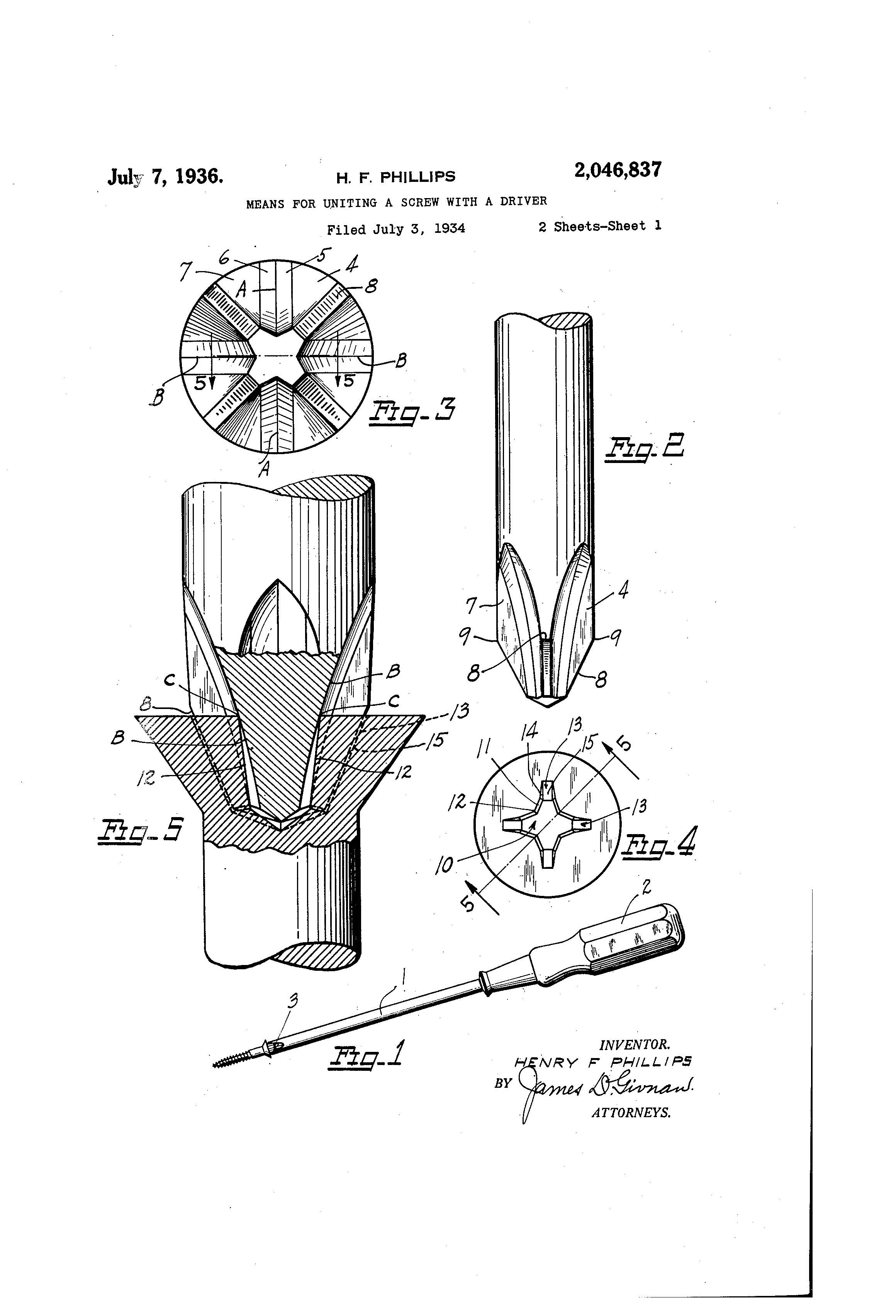Suiter Swantz IP takes a look back at past inventions and inventors with our Patent of the Day.
On this day in 1936, Henry F. Phillips, was granted U.S. Patent No. 2,046,837 for a MEANS FOR UNITING A SCREW WITH A DRIVER.
An excerpt from the patent states:
In contrast to these structural characteristics, of identical form, the elements constituting my present form of composite invention are constructed along complementary angular lines to effect a positive wedging engagement when the screw and driver are joined together in operative relation, instead of teh driver merely occupying the space defined by the recess as is the case in the aforesaid separate screw and driver inventions.
Such failure of the slotted screw to retain the blade-driver, especially in power driven operations, is not only dangerous to the operator, but is likewise, always injurious to the work, especially in the construction of furniture and other types of work wherein the elements to which the screws are being applied become badly mutilated when the power driver leaves the slot, usually during high speed operation of the driver which is most difficult to stop in time to prevent injury to the work.
Accordingly, therefore, the principal object of my invention is to overcome all of the foregoing objectionable features in the operation of a screw by a driver, by providing a composite structure as aforesiad, wherein a screw may be first secured to the end of a driver, and presented tot he work to be dealt with without the inconvenience of the screw dropping from the end of the driver. The screw is also centralized with respect to the driver, not only during its starting operation but also throughout its entire advancement, and during such advancement, the driver is locked in its proper centralized working relation with the screw, and any danger of its leaving the screw is thus entirely eliminated. Another object of the invention is the particular angular formation of the walls of the recess in the screw with respect to the angular formation of the working end or bit of the driver to establish a wedging engagement between the two when united. This same angular formation of both elements is especially designed to also create what might be termed a camming action during the approach of these angular faces toward one another with respect to any substances which might have become lodged within the recess of the screw. It has been found by experiment that a downward thrust of the bit into the recess will instantly dislodge any substance within the recess by causing it to move upwardly and outwardly over the walls of the recess.
Still another object of the invention is the provision of angular faces in such relation to each other that the wedging engagement may be obtained by the mere gravitation of the driver and the operator’s hand applied to it. The angular faces, in other words, are so related to each other that even a slight downward thrust of the driver into the recess will cause a firm wedged engagement between the two elements.
Another feature of the invention is that the same gripping relation, as aforesaid, may be accomplished in screws which are provided with recess having any number of grooves, weather diametrically opposed or not, to receive in wedged engagement, drivers with a corresponding number of vanes. I also wish to point out that my invention provides means in the grooves which are diametrically opposed, to receive the ordinary flat blade-driver such as is now commonly known and used. These blade-drivers may or may not be tapered at their lowermost ends for operative engagement with said grooves. This particular feature enhances the utility of the screw by reason of the fact that any blade-driver may also be used to actuate the screw.
A still further object of the invention accomplished by this specific angular relation between the driver and the screw is that only two sizes of my improved form of the driver are needed to fit all types of screws in sizes ranging from number 5 to 16 inclusive, instead of six or more sizes of the slotted drivers required to fit the same range of sizes of slotted screws.
Suiter Swantz IP is a full-service intellectual property law firm, based in Omaha, NE, serving all of Nebraska, Iowa and South Dakota. If you have any intellectual property questions or need assistance with any patent, trademark or copyright matters and would like to speak to one of our patent attorneys please feel free to contact us.


